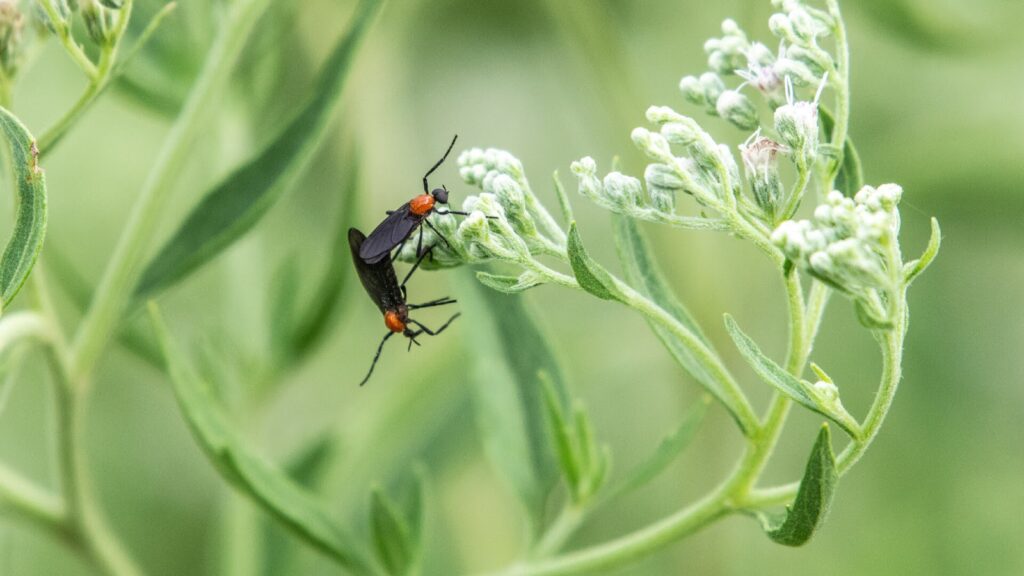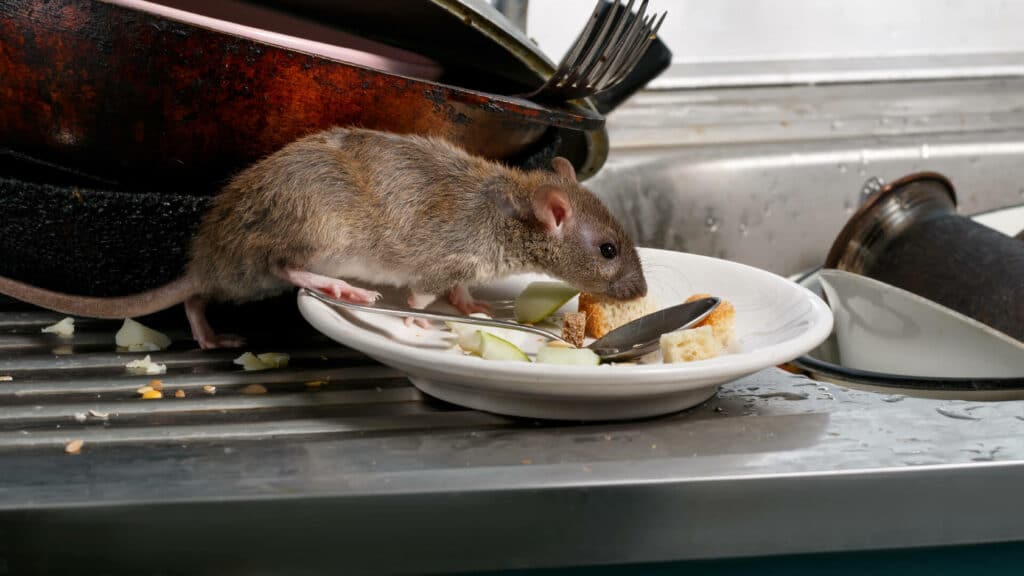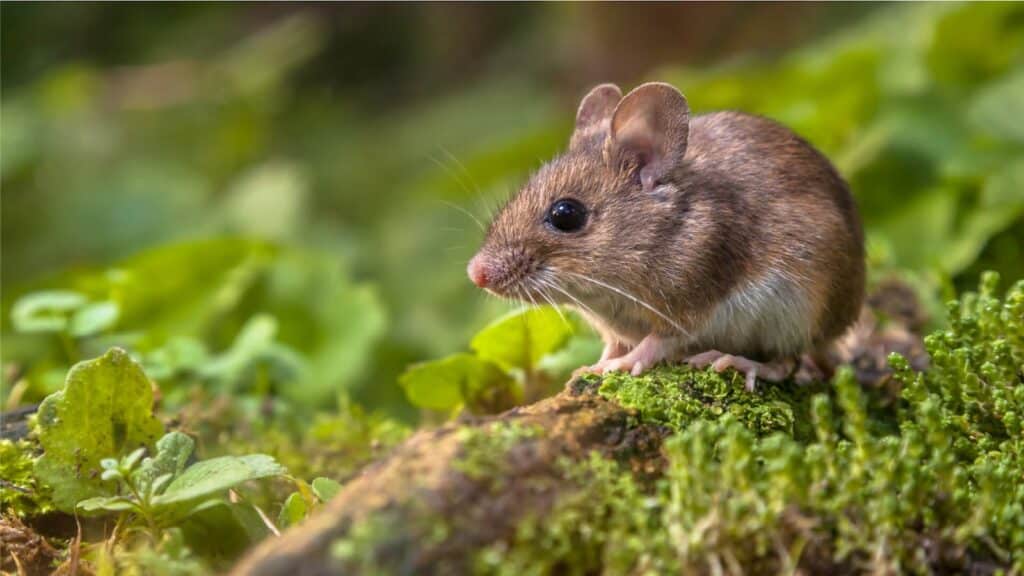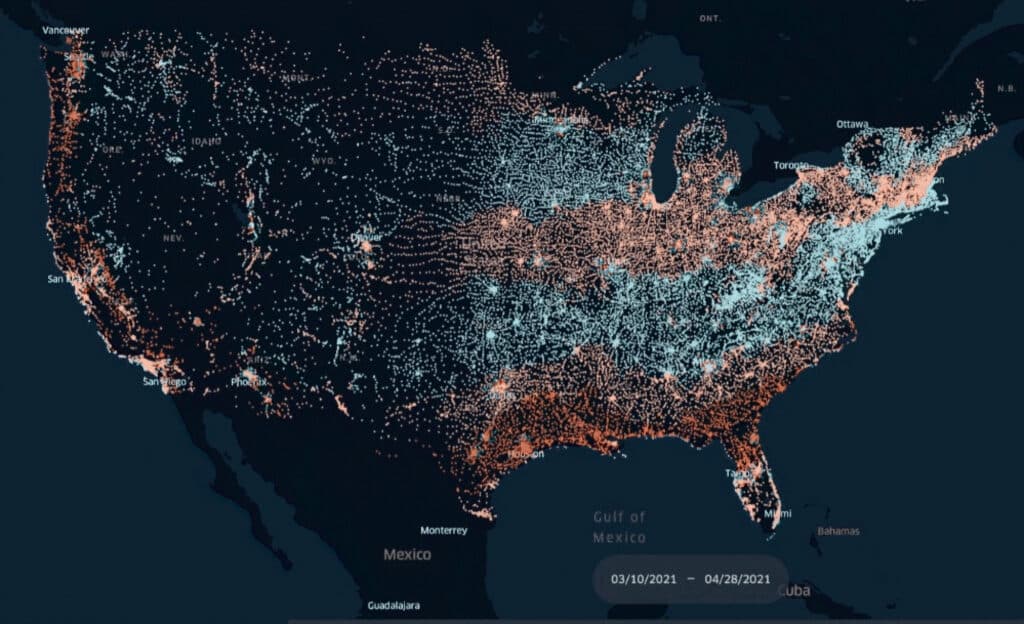The wasp – a winged menace that always seems to be around, threatening you and your family, and seeking to stake its claim under your eaves, in your rock walls, or in your garden or back yard. While wasps come with their own set of concerns, understanding their basic requirements can be the first step in managing them. At the heart of the matter, wasps, like spiders, have three core needs:
- Something to eat
- Something to drink
- Somewhere to live
At Aptive, we monitor pest activity around the US, both at a macro level and on a neighborhood level. With our virtual Pest Neighborhood Activity map, we can better prepare for these potentially harmful pests and offer treatments that control their nesting habits around your home.
To better manage wasp activity around your property, remember these essential aspects: If you can eliminate where wasps live and reduce their food and water sources, you can limit wasp activity!
Paper Wasp vs. Yellow Jacket
The primary wasp you see flying around your house is likely the paper wasp. They are usually colored yellow or yellowish-red. These are the wasps that build their paper nests under your eaves. They typically maintain smaller colonies of at most a couple dozen wasps.
The smaller yellow wasps that often fly around puddles or your can of soda are yellow jackets. Yellow jacket colonies are much larger, with population sizes ranging from 1,000 to 4,000 workers, maybe even as many as 15,000.
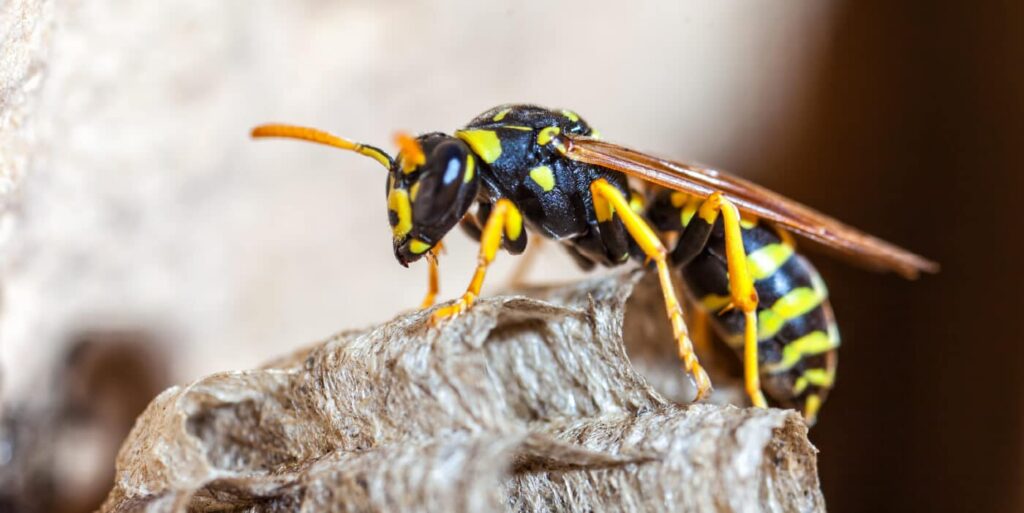
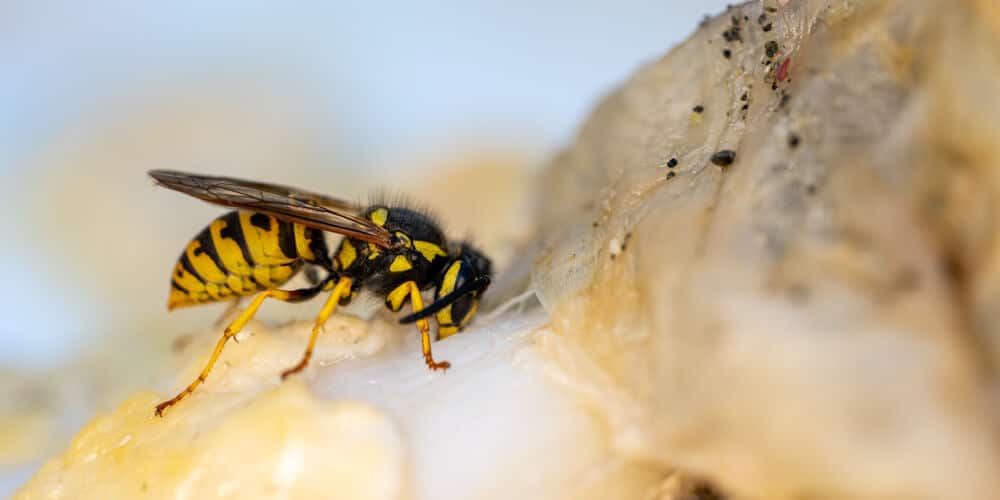
In summary, with paper wasps, you will see more colonies and smaller populations. With yellow jackets, you will see fewer colonies with much greater populations.
Mud Daubers and Solitary Wasps
You’ll also see “solitary” wasps – usually black or darker in color and have a narrow, elongated body shape. The most prominent solitary wasp is the mud dauber – you can find little mud huts on your stucco. These aren’t colonies, just egg capsules. Mud daubers build a mud nest, lay their eggs, and fly off. If you see a little mud nest, check for a hole in the bottom or top. If there is a hole, the egg has hatched, molted through to the adult stage, and chewed its way out. If there’s no hole, break it open! You’ll find the wasp egg, larva, or pupa, along with several paralyzed soft-bodied insects or spiders stuffed inside. Those were carried there by their mothers as her parting gift.
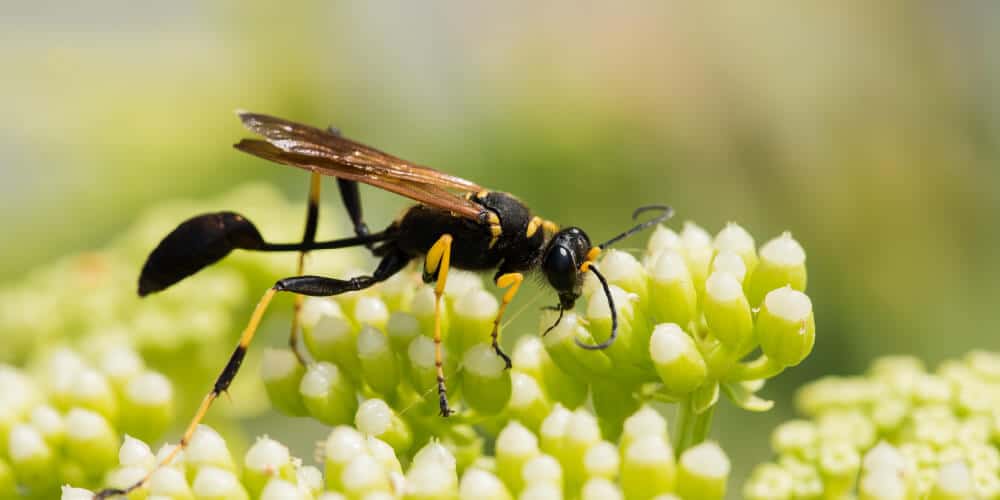
Generally speaking, while all wasps are able and willing to sting, solitary wasps are less aggressive. Social wasps are more aggressive – given they have more to lose. Therefore, they have evolved to be more protective of their colony.
In this article, we’ll focus on the most common wasp pests. However, we won’t discuss bees. Bees are not a pest.
Wasps Need Something to eat
Wasps are omnivorous. They eat primarily proteins and sugars. They get their proteins primarily from other insects and their sugars from plant-based food sources like fruits. Paper wasps will prey on caterpillars and other soft-bodied insects for protein (which qualifies them as beneficial insects). They also feed on nectar and fruits for energy.
Inside
If wasps are inside your house, it means there is outside access. It’s unlikely they’re looking for something to eat inside your home.
Wasps are not only a nuisance when they build nests around your home, but they can also become a problem when they find their way inside. While their primary diet consists of nectar, pollen, and other insects, there are instances when wasps may be attracted to food sources within your home.
Sugary Substances
Wasps are known to have a sweet tooth. They’re attracted to sugary substances such as fruits, fruit juices, syrups, and even sugary drinks like soda. When they find a reliable food source, they’ll keep coming back for more, potentially leading to an infestation. Seal all food containers and clean up spills promptly. Ensure that all windows and doors have screens to limit wasps from entering.
Protein-Rich Foods
While wasps primarily rely on nectar for energy, they also need protein to nourish their larvae. They often prey on other insects like spiders, and even small caterpillars. Regularly inspect your home for small openings or cracks where insects may enter. Keep doors and windows sealed, and consider using screens for added protection.
Pet Food
If you have pets, especially ones that eat wet or canned food, be aware that wasps can be attracted to the smell. They may hover around pet food bowls or even try to feed on it. If your pet doesn’t finish their food in one sitting, remove it promptly. Store pet food in tightly sealed containers.
Garbage and Compost
Wasps are opportunistic feeders, and they are known to scavenge through garbage and compost piles. They are particularly attracted to rotting fruits and vegetables. Ensure that your garbage bins have tight-fitting lids. Clean out compost bins regularly and consider using a compost bin with a secure lid.
By understanding their dietary preferences and taking proactive measures, you can significantly reduce the likelihood of a wasp infestation.
Outside
Wasps living outside feast on a variety of food. They are attracted to areas with flowers, ripe fruits, abundant insects, and trash. If you have fruits and flowers in your garden, you’ll likely attract wasps. Wasps are especially attracted to compost bins and garbage cans filled with nutritious rotting food. Understanding what wasps eat in their natural habitat can shed light on their behavior and help homeowners take proactive measures to reduce infestations.
Nectar and Pollen
Nectar is a primary source of energy for adult wasps. They use their long proboscis to extract nectar from flowers. Pollen, while not a significant part of their diet, provides essential nutrients, particularly protein. Planting wasp-repellent plants like mint, basil, and marigolds around your property can help deter them.
Insects and Arthropods
Wasps are voracious predators of various insects and arthropods, making them valuable contributors to natural pest control. They target a wide range of prey, including flies, caterpillars, spiders, and even other wasps. Maintain a healthy garden by avoiding overuse of pesticides, which can disrupt the natural balance of insect populations. At Aptive, we utilize EPA-approved pesticide products and applications.
Tree Sap
Some wasp species have a penchant for tree sap, which provides them with a concentrated source of sugars and energy. Regularly inspect trees for any wounds or sap leakage. Promptly address any issues to discourage wasps from feasting on sap.
Fruits and Overripe Vegetables
While not their primary food source, certain species of wasps are attracted to overripe or damaged fruits and vegetables. They feed on the sugary juices that may seep from damaged produce. Dispose of overripe or damaged fruits and vegetables promptly to avoid attracting wasps.
Honeydew
Honeydew is a sugary substance excreted by aphids, scales, and other sap-sucking insects. Wasps are known to feed on honeydew, especially in late summer when it is abundant. Regularly inspect plants for signs of honeydew-producing insects. Consider natural predators like ladybugs and lacewings to keep their populations in check.
Understanding the dietary habits of wasps in their natural habitat is crucial for effective pest management. While wasps play a valuable role in controlling insect populations, they can become a nuisance if they establish nests too close to human habitation. By taking proactive measures to limit their access to favored food sources, homeowners can reduce the likelihood of wasp infestations.
Wasps Need Something to drink
Inside
Wasps, like other insects, need water. Again, if you see a wasp inside, it doesn’t want to be in there any more than you want it there. It’s not trying to find your water. It likely just accidentally found its way in. Wasps are highly adaptable creatures that can find sustenance in various environments, including the interior of your home. While their primary diet consists of nectar, pollen, and other insects, they can also be attracted to certain liquid sources indoors.
Sweet Liquids
Wasps have a strong affinity for sugary substances, which provide them with a quick source of energy. They are drawn to sweet liquids like fruit juices, soda, syrup, and even spilled beverages. Ensure that all containers holding sweet liquids are tightly sealed. Clean up spills promptly, especially in outdoor areas where wasps may gain access.
Alcoholic Beverages
In some cases, wasps may be attracted to alcoholic beverages due to their sweet or fruity aromas. They may also be drawn to the sugars in certain cocktails. Keep alcoholic beverages covered when outdoors, and promptly clean up any spills to deter wasps from congregating.
Condensation and Water Droplets
Wasps, like many other insects, require access to water for survival. They are attracted to areas with condensation, leaking pipes, or even droplets of water around sinks and faucets. Fix any plumbing leaks promptly and wipe down surfaces to eliminate standing water. Ensure that drains are clear to limit water accumulation.
Honey and Syrup Residues
If you use honey or syrups in your kitchen, there may be residues left on containers or surfaces. Wasps can be attracted to these sugary remnants. Clean containers and surfaces thoroughly after using honey or syrup. Store them in sealed containers to avoid attracting wasps.
Pet Water Bowls
Wasps may be drawn to pet water bowls, especially if they have been outside and are near an entrance to your home. Keep pet water bowls indoors or, if placed outside, monitor them regularly for signs of wasp activity.
By understanding their preferences and taking proactive measures to eliminate access, you can reduce the chance of a wasp infestation. If you find yourself dealing with a wasp problem, it’s best to seek professional pest control services for effective removal.
Outside
Outside, wasps will find their water source in puddles and other saturated surfaces, though it may not necessarily be there for the water, as we’ll discuss later. While their primary diet consists of nectar and insects, they also have a varied palate for liquids. Understanding what wasps drink outside your home can provide valuable insights into their behavior and help homeowners take proactive measures.
Nectar and Floral Nectars
One of the main sources of sustenance for wasps is nectar. They visit flowers to feed on nectar, simultaneously aiding in pollination. This mutualistic relationship benefits both the wasps and the plants. Planting a variety of native flowers can attract beneficial wasps while beautifying your outdoor space.
Water Sources
Like most creatures, wasps require water for survival. They are often seen near puddles, streams, birdbaths, and other water sources. Ensuring that your outdoor space provides adequate water sources for local wildlife can help limit wasps from seeking hydration near your home.
Tree Sap
Some species of wasps have a taste for tree sap. Sap is a rich source of sugars and nutrients that provides wasps with the energy they need. Regularly inspect trees for signs of sap leakage and address any issues promptly.
Honeydew
Honeydew is a sugary secretion produced by aphids and certain other insects. Wasps are known to feed on honeydew, especially when it’s abundant. Keep an eye out for honeydew-producing insects on your plants and take appropriate action to manage their populations.
Fruits and Overripe Vegetables
While not their primary food source, some wasps may be attracted to overripe or damaged fruits and vegetables, particularly if they’re oozing sugary juices. Dispose of overripe or damaged produce promptly to deter wasps from feeding in your outdoor space.
Understanding the dietary preferences of wasps outside your home is key to maintaining a harmonious coexistence with these beneficial insects. While wasps can be a nuisance, they play a vital role in natural pest control. By providing appropriate water sources and avoiding potential attractants, you can help minimize the likelihood of wasp infestations around your property.
Wasps Need Somewhere to live
Outside
Paper wasps, as their name implies, build paper-like nests from chewed wood fibers and saliva. They prefer eaves, ledges, or railings for their nests. The less human activity, the better. When you see them flying around stagnant puddles, they need that extra water to create the saliva to mix with chewed wood fibers to create an actual paper that acts as the structure for their nests. While they play a vital role in natural pest control, their nests can become a source of concern when they are built too close to human habitation.
Eaves and Roof Overhangs
Eaves and roof overhangs provide an ideal location for wasps to build their nests. These sheltered areas offer protection from the elements and easy access to the outdoors. Regularly inspect eaves and roof overhangs for signs of wasp activity.
Trees and Shrubs
Trees and shrubs, especially those with dense foliage, can be attractive nesting sites for wasps. They may build nests in the branches or within the vegetation itself. Keep trees and shrubs well-trimmed and monitor them for signs of wasp activity.
Porches and Decks
The spaces beneath porches, decks, and patios can offer a sheltered location for wasps to build their nests. These areas are often overlooked and can provide an undisturbed environment for colonies to grow. Use fine mesh screens or wire mesh to seal off the undersides of porches and decks, limiting wasps from accessing these areas.
Understanding the favored nesting sites of wasps is crucial for effective pest management. While wasps play a valuable role in controlling insect populations, they can become a major problem if they establish nests too close to human habitation. By taking proactive measures to limit their access to preferred nesting sites, homeowners can significantly reduce the risk of a wasp infestation.
Inside
While uncommon, paper wasps sometimes build nests in undisturbed indoor spaces like attics or unused rooms. They will only make a nest there if they have one or more points of entry and exit. If you see a paper wasp flying around inside, no need to worry. It likely found its way in through an open door or window. It can be taken care of with a fly swatter or a well-aimed rubber band. If you see individual wasps inside more than once over a few days or weeks, there’s likely a nest built outside near a point of entry. The point of entry is likely a window screen with holes, a crack or hole in the caulking around doors or windows, a worn weather seal under the door, or an entry in through your attic. Sealing these openings can help limit wasps and other pests from entering your home. If you see multiple wasps flying around at the same time, you may have a nest inside.
Attics and Crawl Spaces
Attics and crawl spaces provide a warm, sheltered environment for wasps to establish their nests. They often find openings or gaps in the exterior of your home to gain access to these spaces. If you discover a wasp nest in your attic or crawlspace, it’s best to seek professional pest control services for effective removal.
Wall Voids
Wasps are skilled at exploiting small openings in your home’s exterior to access wall voids. Once inside, they build their nests within the hollow spaces between walls. To remove a wasp nest from a wall void, it’s crucial to consult a professional pest control service. Attempting to do it yourself can be dangerous and may cause further damage.
Chimneys
Chimneys, especially those that are not in use, can provide an attractive nesting site for wasps. They may enter through the top of the chimney or find gaps in the flue. To safely remove a wasp nest from a chimney, it’s recommended to consult a professional pest control service, as accessing this area can be hazardous.
Window and Door Frames
Wasps may find small openings or gaps around window and door frames to access the interior of your home. They may build nests in these hidden spaces. Seal any gaps or openings around window and door frames to prevent wasps from entering. If you suspect a nest is already present, seek professional assistance.
Ceiling Voids
In some cases, wasps may find their way into the ceiling voids of your home, particularly if there are openings near light fixtures or vents. Removing a wasp nest from a ceiling void requires professional expertise. It’s important to avoid attempting this yourself, as it can be dangerous and may lead to further issues.
Discovering a wasp nest inside your home can be a cause for concern, but it’s important to approach the situation with caution. Seeking professional pest control services is an effective way to remove a wasp nest from your home. Additionally, taking proactive measures to seal off potential entry points can help reduce future infestations. Remember, when it comes to dealing with wasps inside your home, professional assistance is a recommended course of action.
Now that you know their “something to eat”, “something to drink”, and “Somewhere to live”, you know your wasps enough to control them! You also know wasps well enough to understand how hard they can be to control. If a wasp problem persists or becomes unmanageable, seeking professional assistance from a reputable pest control company like Aptive is recommended to experience an effective solution.
Eliminate their “something to eat”
To disrupt their food supply:
- Manage your garden.
- Avoid leaving ripe fruits unharvested.
- Ensure your garbage bins are tightly sealed, and compost heaps are covered. If you see wasps flying around your fruit trees, cheer them on! They are looking for the worms that infest your fruit.
Eliminate their “something to drink”
Change the water in bird baths regularly. Locate and eliminate standing water. Reduce your watering schedule if you are creating saturated conditions. If you are creating mud, you may see mud daubers flying around collecting mud for their nests.
Eliminate their “somewhere to live”
This is ultimately the way you control a wasp problem. As soon as you see a nest being built under your eaves or around your property, sweep it down. It is best to take a contact kill wasp spray carefully to the nest in the early morning or late evening when all the workers are at the nest after a hard day’s work or night’s rest. Treat the wasps with the spray, then sweep down the nest. By doing this, you’ve done what’s needed to reduce the wasp activity around your house. If you don’t spray the nest and sweep it down, they can rebuild.
To address the obvious, it is not possible to prevent or eliminate flying wasp activity in the home without a screen. Since wasps fly, they’ll soar over any ground pesticide barrier you may have established. While it is possible to establish a treatment on the eaves to reduce nest building, it is not possible to prevent your neighbor’s wasps from flying into your home.
Do wasp traps help? Sure. However, when you have hundreds of wasps flying around the neighborhood, traps can only do so much.
Choose a pest expert
Knowing where wasps thrive and what they seek can be your best defense against these winged warriors. But why wage this war alone? With Aptive, you have the industry’s top experts by your side. We understand the intricacies of their habits and habitats and are equipped with EPA-approved products to address your wasp woes. And, if they decide to make an unexpected comeback, we’ll be right there with you – at no additional cost. Experience the Aptive difference and sign up for wasp control today.





